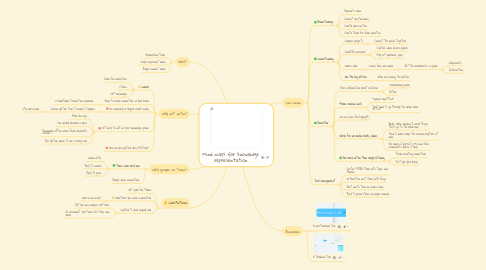
1. What
1.1. Hierarchical trees
1.2. Nodes represent ideas
1.3. Edges connect ideas
2. Why not notes?
2.1. Linear!
2.1.1. Good for narratives
2.1.2. Stories
2.1.3. Not knowledge!
2.2. Have to make connections in your brain
2.2.1. => Additional translation overhead
2.3. No summary or "higher order" nodes
2.3.1. Cornell system tries to make it happen
2.3.1.1. Still very crude
2.4. Not easy to edit as your knowledge grows
2.4.1. More like logs
2.4.2. Can quickly become a mess
2.4.3. Knowledge often comes from disparate sources
2.4.4. The system needs to be a "living" one
2.5. How will you capture URLs? Pictures?
3. Why graphs or trees?
3.1. Trees scale very well
3.1.1. Unlike notes
3.1.2. Easy to search
3.1.3. Easy to grow
3.2. Graphs allow connections
4. Limitations
4.1. Not good for tables
4.2. Sometimes you need a narrative
4.2.1. Such as an essay
4.3. Limited to your display size
4.3.1. But you can collapse sub-trees
4.3.2. Or disconnect sub-trees into their own maps
5. Use cases
5.1. Brainstorming
5.1.1. Generate ideas
5.1.2. Connect related ideas
5.1.3. Create idea clusters
5.1.4. Curate them for final selection
5.2. Understanding
5.2.1. Complex projects
5.2.1.1. Connect the pieces together
5.2.2. Scientific research
5.2.2.1. Capture ideas across papers
5.2.2.2. Map out problems, gaps
5.2.3. Source code
5.2.3.1. Source files are linear
5.2.3.1.1. But the machinery is a graph
5.2.4. See the big picture!
5.2.4.1. While also having the details
5.3. Education
5.3.1. Store information about material
5.3.1.1. Summarizing nodes
5.3.1.2. Details
5.3.2. Makes reviews easy
5.3.2.1. "Spaced repetition"
5.3.2.2. Don't have to go through the whole video or text
5.3.3. Use cue icons for highlights
5.3.4. Works for all media: books, videos
5.3.4.1. Books: While reading I mark things that'll go to the mind map
5.3.4.2. Then I make maps for several chapters at once
5.3.4.3. For videos I play at 0.75x and take screenshots where it helps
5.3.5. Far more active than simply listening
5.3.5.1. You're creating connections
5.3.5.2. Just like your brain
5.4. Task management
5.4.1. Cluster "TODO" items into topics and themes
5.4.2. Prioritize next items with flags
5.4.3. Don't waste time on useless ones
5.4.4. Easy to prune items no longer needed
